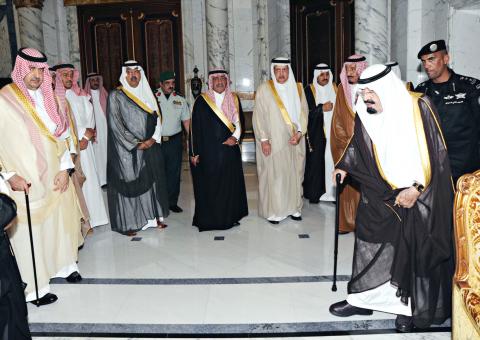Saudi Arabia was preparing yesterday to bury Saudi Crown Prince Nayef bin Abdulaziz Al Saud amid worldwide condolences, as Saudi Minister of Defense and Aviation Prince Salman bin Abdulaziz Al Saud appeared poised to become the new heir apparent.
An aircraft bearing the body of Nayef left Geneva early yesterday for the kingdom’s western city of Jeddah, Saudi-owned al-Arabiyah television reported.
The funeral of the Persian Gulf nation’s security czar was expected to take place later in the Muslim holy city of Mecca after sunset.

Photo: Reuters
He was to be buried in al-Adl cemetery near the Grand Mosque, where several members of the royal family and prominent Islamic scholars are interred, the Okaz daily said.
“Crown Prince Nayef devoted his life to promoting the security of Saudi Arabia,” said UN Secretary-General Ban Ki-moon, while US President Barack Obama praised his cooperation in the fight against terror that “saved countless American and Saudi lives.”
French President Francois Hollande said his country had lost a “friend” and the president of the Swiss Confederation, where Nayef died, offered Bern’s “deepest condolences.”
The 79-year-old prince died of “cardiac problems” while at his brother’s residence in Geneva, a medical source in the city who asked not to be identified said.
Nayef’s death, just eight months after he replaced his late brother, Sultan bin Abdulaziz Al Saud, as crown prince, raises the issue of succession because of the advanced age of the first line of apparent heirs, in a time of turmoil rocking the Arab world.
King Abdullah himself is 88 and ailing and nobody is officially in line to replace Nayef.
However, his brother, Salman, 76, who took the defense and aviation portfolio after Sultan’s death, appears to be a strong candidate.
“Prince Salman is the most likely successor,” Saudi political scientist Khaled al-Dakheel said.
“All expectations point to Prince Salman to succeed Prince Nayef for his experience in administration, security and politics,” agreed Anwar Eshqi, head of the Jeddah-based Middle East Center for Strategic Studies.
And Jane Kinninmont, a senior research fellow for the Middle East and North Africa at London’s Chatham House, said Salman is “generally assumed to be the next in line.”
In 2006, the Saudi monarch established the Allegiance Council, a body of about 35 senior princes, as a new succession mechanism whose long-term aim was to choose the crown prince.
Nayef was the middle prince of the Sudairi Seven, the formidable bloc of sons of late Saudi king Abdulaziz Al Saud by a favorite wife, Princess Hassa bint Ahmad al-Sudairi.
In addition to Salman, remaining Sudairis include Prince Abdul Rahman bin Abdulaziz Al Saud, Prince Turki II bin Abdulaziz Al Saud and Prince Ahmed bin Abdulaziz Al Saud, who is deputy interior minister and likely to succeed Nayef at the security helm.
Nayef, who spearheaded Saudi Arabia’s clampdown on al-Qaeda following a wave of attacks in the conservative kingdom between 2003 and 2006, became heir to the throne in October last year.
“He was one of the pillars of stability in the kingdom,” al-Jazirah daily wrote. “He managed to overcome crises and navigate this country to the shores of safety.”
Nayef traveled abroad several times this year for medical reasons, including to Algeria, the US and Switzerland, where he was shown on television in Geneva three days ago greeting supporters.
The nature of his illness was not made public.
Seen as more conservative than Abdullah, Nayef was a staunch defender of the Saudi dynasty and resisted any form of opposition.
He ordered and oversaw a fierce crackdown on al-Qaeda, forcing the jihadist group’s leaders and militants to flee to Yemen, from where they continue to be a thorn in the side of Saudi interests.

China yesterday held a low-key memorial ceremony for the 1937 Nanjing Massacre, with Chinese President Xi Jinping (習近平) not attending, despite a diplomatic crisis between Beijing and Tokyo over Taiwan. Beijing has raged at Tokyo since Japanese Prime Minister Sanae Takaichi last month said that a hypothetical Chinese attack on Taiwan could trigger a military response from Japan. China and Japan have long sparred over their painful history. China consistently reminds its people of the 1937 Nanjing Massacre, in which it says Japanese troops killed 300,000 people in what was then its capital. A post-World War II Allied tribunal put the death toll

‘NO AMNESTY’: Tens of thousands of people joined the rally against a bill that would slash the former president’s prison term; President Lula has said he would veto the bill Tens of thousands of Brazilians on Sunday demonstrated against a bill that advanced in Congress this week that would reduce the time former president Jair Bolsonaro spends behind bars following his sentence of more than 27 years for attempting a coup. Protests took place in the capital, Brasilia, and in other major cities across the nation, including Sao Paulo, Florianopolis, Salvador and Recife. On Copacabana’s boardwalk in Rio de Janeiro, crowds composed of left-wing voters chanted “No amnesty” and “Out with Hugo Motta,” a reference to the speaker of the lower house, which approved the bill on Wednesday last week. It is

FALLEN: The nine soldiers who were killed while carrying out combat and engineering tasks in Russia were given the title of Hero of the Democratic People’s Republic of Korea North Korean leader Kim Jong-un attended a welcoming ceremony for an army engineering unit that had returned home after carrying out duties in Russia, North Korean state media KCNA reported on Saturday. In a speech carried by KCNA, Kim praised officers and soldiers of the 528th Regiment of Engineers of the Korean People’s Army (KPA) for “heroic” conduct and “mass heroism” in fulfilling orders issued by the ruling Workers’ Party of Korea during a 120-day overseas deployment. Video footage released by North Korea showed uniformed soldiers disembarking from an aircraft, Kim hugging a soldier seated in a wheelchair, and soldiers and officials

Cozy knits, sparkly bobbles and Santa hats were all the canine rage on Sunday, as hundreds of sausage dogs and their owners converged on central London for an annual parade and get-together. The dachshunds’ gathering in London’s Hyde Park came after a previous “Sausage Walk” planned for Halloween had to be postponed, because it had become so popular organizers needed to apply for an events licence. “It was going to be too much fun so they canceled it,” laughed Nicky Bailey, the owner of three sausage dogs: Una and her two 19-week-old puppies Ember and Finnegan, wearing matching red coats and silver